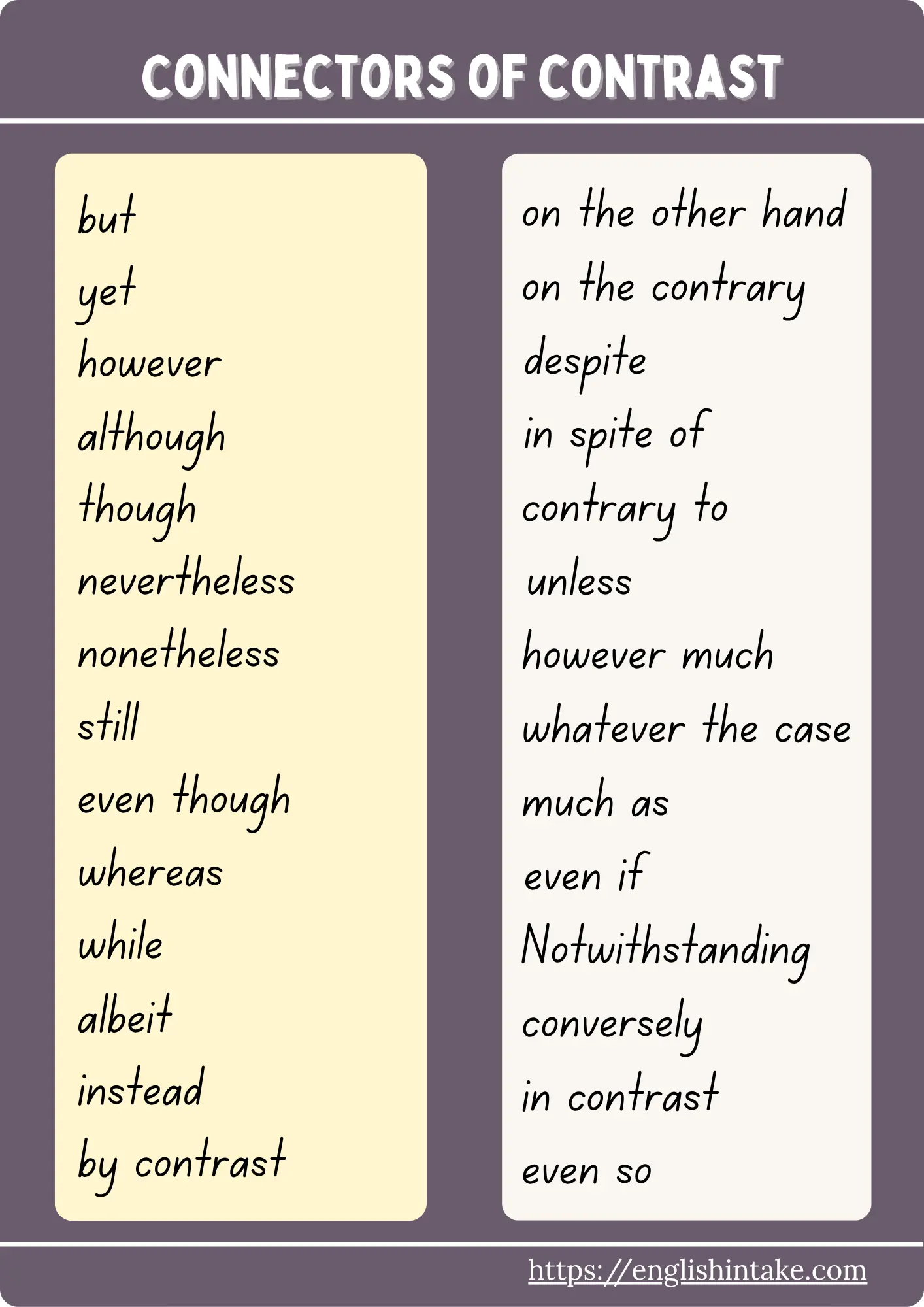1. What are connectors of contrast?
Connectors of contrast or contrasting conjunctions highlight differences between ideas in sentences. They signal that the information following the connector contradicts what has come before.
2. List of connectors of contrast
Below is a list of common words that help introduce contradictory statements.

- However
- Nevertheless
- Nonetheless
- On the other hand
- On the contrary
- In contrast
- By contrast
- Whereas
- While
- Although
- Even though
- Though
- Despite
- In spite of
- Yet
- But
- Still
- Conversely
- Albeit
- Notwithstanding
The table below summarises different contrast connectors, their usage, and example sentences to help you understand how to use them correctly.
| Type | Connector | Usage | Example sentence |
|---|---|---|---|
| Conjunctive adverbs | however, nevertheless, nonetheless, still, conversely | Used to introduce contrast between independent clauses; preceded by a semicolon and followed by a comma. | He studied very hard; however, he did not pass the exam. |
| Comparative phrases | on the other hand, in contrast, by contrast | Used to highlight differences between two ideas; followed by a comma if placed at the beginning of a sentence. | She loves classical music. In contrast, her brother listens to heavy metal. |
| Contradiction | On the contrary | Used to directly contradict a previous statement; preceded by a semicolon or period. | People think she is unfriendly. On the contrary, she is very kind. |
| Subordinating conjunctions | whereas, while | Introduce subordinate clauses expressing direct contrast; a comma is used when the subordinate clause comes first. | She prefers coffee, whereas he always drinks tea. |
| Concessive conjunctions | although, even though, though, albeit | Introduce dependent clauses with contrasting information; a comma is used if they start a sentence. | Although he was tired, he continued working on his project. |
| Prepositional contrast | despite, in spite of, notwithstanding | Followed by noun phrases or -ing forms; "the fact that" can be added to introduce a full clause. | Despite the rain, they went for a walk in the park. |
| Coordinating conjunctions | But, yet | Join two independent clauses; a comma is required before them. | She wanted to go to the party, but she had to work late. |
| Other expressions | even so, regardless of, be that as it may | Introduce surprising contrasts or unexpected outcomes. | She was not fully prepared. Even so, she performed well in the competition. |
Now, let's look at them in more detail. Below, we will explore each category of contrast connectors, explaining their specific functions, punctuation rules, and providing additional examples to illustrate how they are used in different contexts.
3. Conjunctive adverbs
The connectors however, nevertheless, nonetheless, still, and conversely are conjunctive adverbs used to introduce contrasting information between independent clauses. When linking two independent clauses, they are preceded by a semicolon and followed by a comma. They can also start a new sentence, in which case they are followed by a comma.
- It was raining heavily; however, we decided to continue our hike.
- The results were disappointing. Nevertheless, we learned valuable lessons.
- He lacked experience; still, he managed the project effectively.
4. Comparative connectors
The phrases on the other hand, in contrast, and by contrast highlight a difference between two statements. They are commonly used when comparing two subjects or situations. When placed at the beginning of a sentence, they are followed by a comma. If used in the middle of a sentence, they are usually preceded by a period or semicolon.
- Urban life offers many conveniences. On the other hand, it can be stressful.
- Southern regions are warm and humid. By contrast, northern areas have dry winters.
5. Contradiction connector
The phrase on the contrary is used when directly contradicting a previous statement rather than simply presenting a contrasting idea. It is often preceded by a semicolon or period and followed by a comma.
- I didn't find it boring; on the contrary, I thought it was fascinating.
6. Subordinating conjunctions (direct contrast)
The words whereas and while introduce subordinate clauses that express a direct contrast between two elements. When the subordinate clause comes before the main clause, a comma is used. If it follows the main clause, no comma is required.
- My sister loves action movies, whereas I prefer documentaries.
- While the first act was slow, the finale was thrilling.
7. Contrastive subordinators
The connectors although, even though, though, and albeit introduce subordinate clauses that present contrasting information. When the subordinate clause appears first, it should be followed by a comma. The word albeit is more formal and is followed by an adjective, adverb, or noun phrase.
- Although the recipe seemed simple, it required special techniques.
- He accepted the offer, albeit with some reservations.
8. Prepositional contrast
The phrases despite, in spite of, and notwithstanding are prepositions that must be followed by a noun phrase or the -ing form of a verb. To introduce a full clause, they are often combined with "the fact that."
- Despite the traffic delay, we arrived early.
- In spite of having limited resources, they completed the project.
- Notwithstanding the company's objections, the policy was implemented.
- We arrived on time, in spite of the fact that we missed the train.
9. Coordinating conjunctions
The words but and yet are coordinating conjunctions. When they connect complete sentences, a comma is placed before them.
- The plan looked perfect on paper, but it failed in practice.
- She trained diligently for months, yet didn't qualify.
10. Additional contrast connectors
Other useful contrast expressions include even so, regardless of, and be that as it may. These phrases function similarly to conjunctive adverbs, introducing unexpected or opposing ideas.
- The risks were considerable. Even so, the soldiers decided to proceed.
- Regardless of the challenges, we must meet the deadline.
- Be that as it may, we still need to follow regulations.
11. Special cases
The word still can function as a sentence adverb to introduce an idea that is surprising given the previous statement. In this case, it is typically placed at the beginning of the sentence and followed by a comma.
- She had never cooked the dish before. Still, it turned out delicious.
